The AMD Radeon R9 Fury Review, Feat. Sapphire & ASUS
by Ryan Smith on July 10, 2015 9:00 AM ESTCompute
Shifting gears, we have our look at compute performance. As compute performance will be more significantly impacted by the reduction in CUs than most other tests, we’re expecting the performance hit for the R9 Fury relative to the R9 Fury X to be more significant here than under our gaming tests.
Starting us off for our look at compute is LuxMark3.0, the latest version of the official benchmark of LuxRender 2.0. LuxRender’s GPU-accelerated rendering mode is an OpenCL based ray tracer that forms a part of the larger LuxRender suite. Ray tracing has become a stronghold for GPUs in recent years as ray tracing maps well to GPU pipelines, allowing artists to render scenes much more quickly than with CPUs alone.

For LuxMark with the R9 Fury X already holding the top spot, the R9 Fury cards easily take the next two spots. One interesting artifact of this is that the R9 Fury’s advantage over the GTX 980 is actually greater than the R9 Fury X’s over the GTX 980 Ti’s, both on an absolute and relative basis. This despite the fact that the R9 Fury is some 13% slower than its fully enabled sibling.
For our second set of compute benchmarks we have CompuBench 1.5, the successor to CLBenchmark. CompuBench offers a wide array of different practical compute workloads, and we’ve decided to focus on face detection, optical flow modeling, and particle simulations.
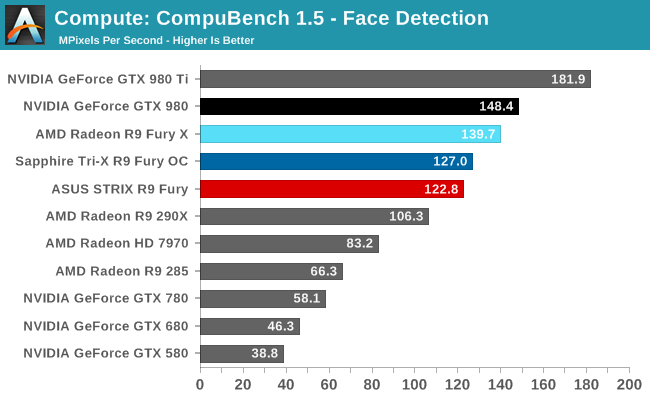
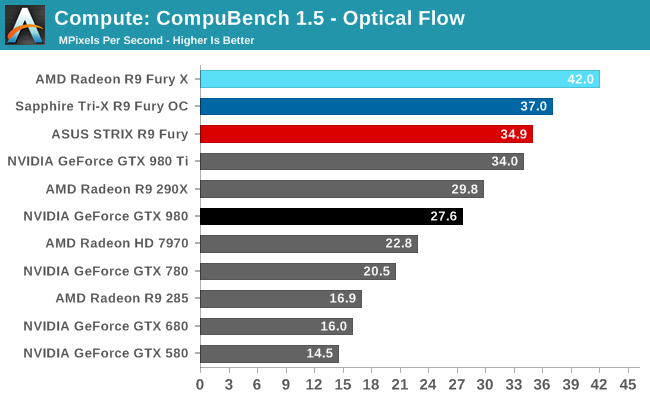

Not unlike LuxMark, tests where the R9 Fury X did well have the R9 Fury doing well too, particularly the optical flow sub-benchmark. The drop-off in that benchmark and face detection is about what we’d expect for losing 1/8th of Fiji’s CUs. On the other hand the particle simulation benchmark is hardly fazed beyond the clockspeed drop, indicating that the bottleneck lies elsewhere.
Our 3rd compute benchmark is Sony Vegas Pro 13, an OpenGL and OpenCL video editing and authoring package. Vegas can use GPUs in a few different ways, the primary uses being to accelerate the video effects and compositing process itself, and in the video encoding step. With video encoding being increasingly offloaded to dedicated DSPs these days we’re focusing on the editing and compositing process, rendering to a low CPU overhead format (XDCAM EX). This specific test comes from Sony, and measures how long it takes to render a video.
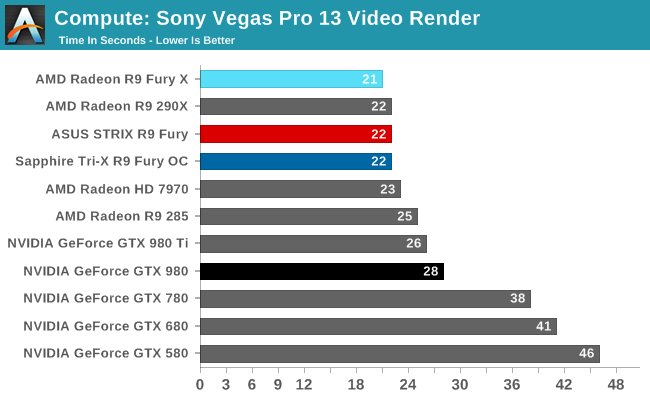
At this point Vegas is becoming increasingly CPU-bound and will be due for replacement. The R9 Fury comes in one second behind the chart-topping R9 Fury X, at 22 seconds.
Moving on, our 4th compute benchmark is FAHBench, the official Folding @ Home benchmark. Folding @ Home is the popular Stanford-backed research and distributed computing initiative that has work distributed to millions of volunteer computers over the internet, each of which is responsible for a tiny slice of a protein folding simulation. FAHBench can test both single precision and double precision floating point performance, with single precision being the most useful metric for most consumer cards due to their low double precision performance. Each precision has two modes, explicit and implicit, the difference being whether water atoms are included in the simulation, which adds quite a bit of work and overhead. This is another OpenCL test, utilizing the OpenCL path for FAHCore 17.
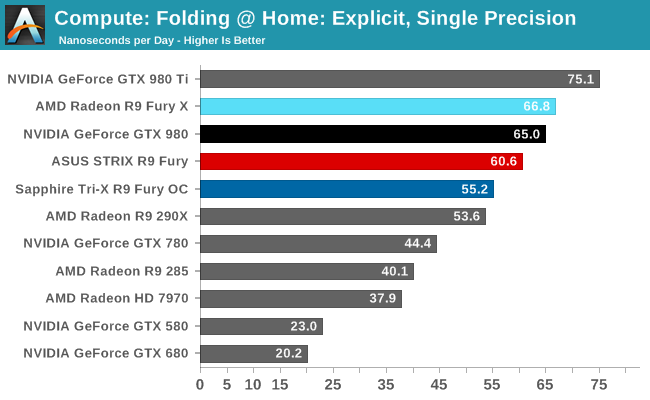
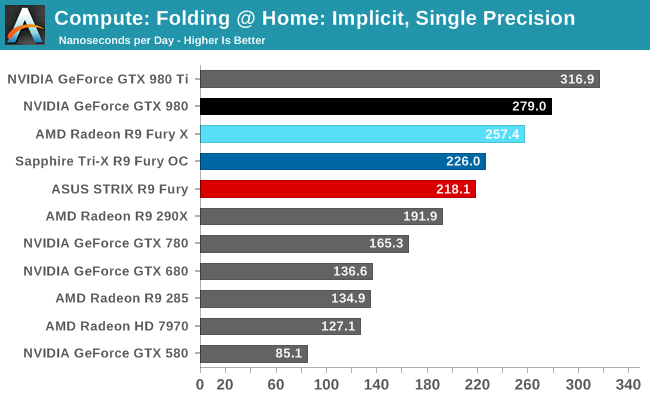

Overall while the R9 Fury doesn’t have to aim quite as high given its weaker GTX 980 competition, FAHBench still stresses the Radeon cards. Under single precision tests the GTX 980 pulls ahead, only surpassed under double precision thanks to NVIDIA’s weaker FP64 performance.
Wrapping things up, our final compute benchmark is an in-house project developed by our very own Dr. Ian Cutress. SystemCompute is our first C++ AMP benchmark, utilizing Microsoft’s simple C++ extensions to allow the easy use of GPU computing in C++ programs. SystemCompute in turn is a collection of benchmarks for several different fundamental compute algorithms, with the final score represented in points. DirectCompute is the compute backend for C++ AMP on Windows, so this forms our other DirectCompute test.
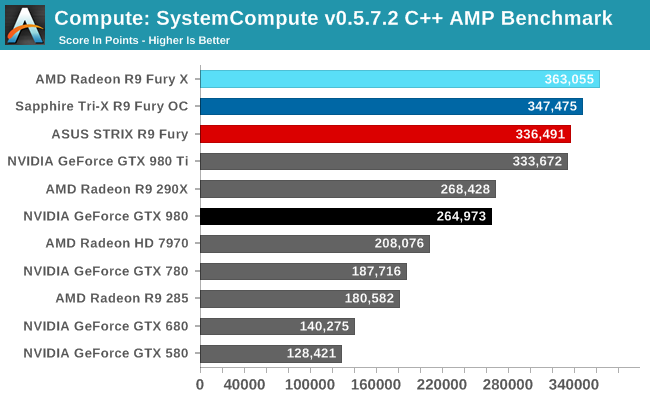
As with our other tests the R9 Fury loses some performance on our C++ AMP benchmark relative to the R9 Fury X, but only around 8%. As a result it’s competitive with the GTX 980 Ti here, blowing well past the GTX 980.










288 Comments
View All Comments
CiccioB - Monday, July 13, 2015 - link
For a GPU that was expected to beat Titan X hands down, just being faster than 980 is quite a fail.Also due to the high cost technology involved in producing it.
Be happy for that, and just wait or DX12 to have some hope to gain few FPS with respect to the competitor.
I just think DX12 is not going to change anything (whatever these cards will gain will be the same for nvidia cards) and few FPS more or less is not what we expected from this top ties class (expensive) GPU.
Despite the great steps ahead made by AMD in power consumption, it still is a fail.
Large, expensive, still consuming more, and badly scaling.
Hope that with the new 16nm FinFet PP things will change radically, or we will witness a 2 year dominance again by nvidia with high prices.
superjim - Monday, July 13, 2015 - link
Used 290's are going for sub-$200 (new for $250). Crossfire those and you get better performance for much less.P39Airacobra - Tuesday, July 14, 2015 - link
Ok compared to the Fury X, The Regular R9 Fury makes a bit more sense than the X model. It is priced better (But still priced a bit too much) And it has almost even performance with the X model. However the power consumption is still insane and unreasonable for todays standards! And the temps are way too high for a triple fan card! With a 70c temp running triple fans I doubt there is any room at all for overclocking! I do respect this card's performance! But it is just not worth it for the price you have to pay for a hefty PSU, And the very loud and expensive cooling setup you will have to put inside your case! To be honest: If I was stuck with a old GTX 660 Ti, And someone offered me a R9 Fury for even trade, I would not do it!ES_Revenge - Tuesday, July 14, 2015 - link
The power consumption is not insane or unreasonable for "today's standards". Only the GTX 960, 970, 980, Titan X are better. So it's unreasonable for Nvidia's new standard but it's actually an improvement over Hawaii, etc. of the past.Compared to current Nvidia offerings, it's bad yeah but we can't really established standards on their cards alone. R9 390/X, 380, etc. are still power hungry for their performance and they are still "today's" cards, like it or not.
Don't get me wrong I agree they really need to start focusing on power/heat reduction, but we're not going to see that from AMD until their next gen cards (if they make it that far, lol).
Gunbuster - Wednesday, July 15, 2015 - link
AMD thread with no Chizow comments? My world is falling apart :POxford Guy - Wednesday, July 15, 2015 - link
I'm sure this person has more than one alias.FlushedBubblyJock - Thursday, July 16, 2015 - link
We'd know him by his words, his many lengthy words with links and facts up the wazoo, and he is so proud he would not hide with another name, like a lousy, incorrect, uninformed, amd fanboy failure.FlushedBubblyJock - Wednesday, July 15, 2015 - link
Just think about placing your bare hand on 3 plugged in 100 Watt light bulbs ... that's AMD's housefire for you !My god you could cook a steak on the thing.
3X 100 watter light bulbs frying everything in your computer case... awesome job amd.
Oxford Guy - Wednesday, July 15, 2015 - link
Because the GTX 480 was quieter, had better performance per watt, and was a fully-enabled chip.FlushedBubblyJock - Thursday, July 16, 2015 - link
So the 480 being hot makes this heated furnace ok ?What exactly is the logic there ?
Are you a problematic fanboy for amd ?